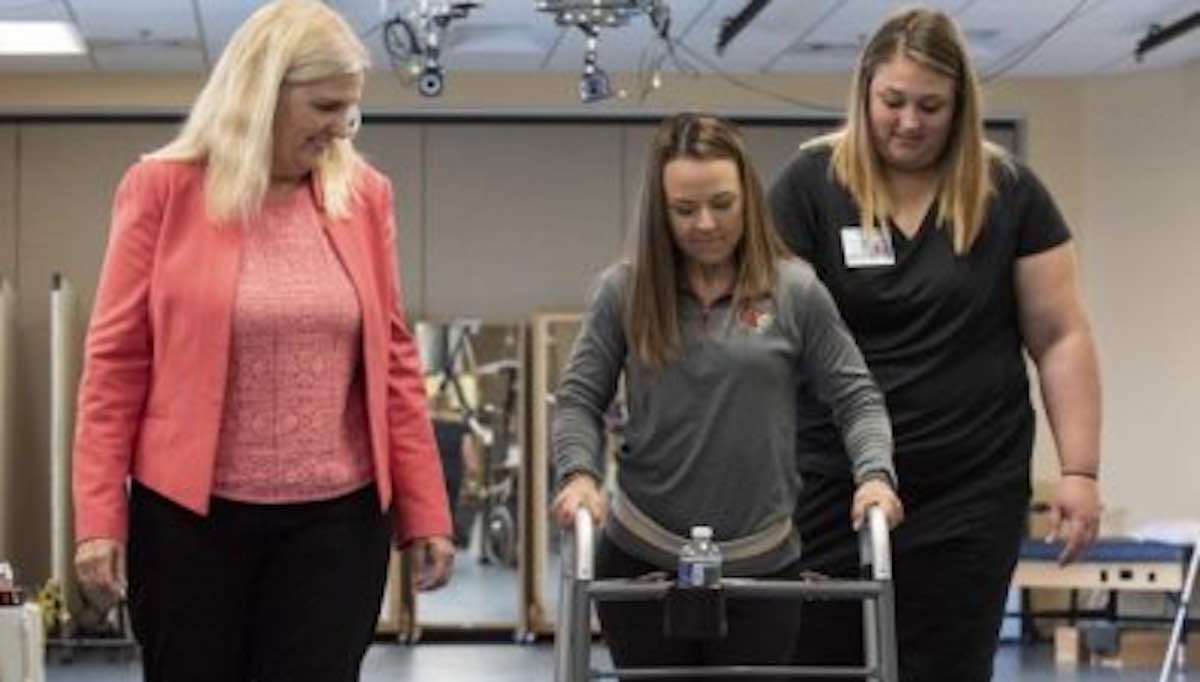Four people who have been paralyzed from the waist down are achieving what was previously thought to be impossible thanks to a groundbreaking new therapy.
Using a spinal implant, two of the participants living with traumatic, motor complete spinal cord injury are able to walk independently once more while the other two are able to stand and take limited steps.
When the four participants joined the study, they were at least 2.5 years post injury. They were unable to stand, walk or voluntarily move their legs. Eight to nine weeks prior to the implantation of an epidural stimulator, they started training their motor skills by manual facilitating stepping on a treadmill for five days per week, two hours each day.
Although there were no changes to their locomotor abilities prior to the implant, following the epidural stimulation, participants were able to step when the stimulator was on and the individual intended to walk. Two of the participants were even able to achieve walking over ground – in addition to on a treadmill – with assistive devices, such as a walker and horizontal poles for balance while the stimulator was on.
RELATED: After 15 Years in a Vegetative State, Nerve Stimulation Restores Consciousness
“Being a participant in this study truly changed my life, as it has provided me with a hope that I didn’t think was possible after my car accident,” said participant Kelly Thomas, a 23-year-old from Florida. “The first day I took steps on my own was an emotional milestone in my recovery that I’ll never forget as one minute I was walking with the trainer’s assistance and, while they stopped, I continued walking on my own. It’s amazing what the human body can accomplish with help from research and technology.”
Jeff Marquis, a 35-year-old Wisconsin native who now lives in Louisville, was the first participant in this study to attain bilateral steps.
“The first steps after my mountain biking accident were such a surprise, and I am thrilled to have progressed by continuing to take more steps each day. In addition, my endurance has improved, as I’ve regained strength and the independence to do things I used to take for granted like cooking and cleaning,” said Marquis. “My main priority is to be a participant in this research and further the findings, as what the University of Louisville team does each day is instrumental for the millions of individuals living with paralysis from a spinal cord injury.”
This research is based on two distinct treatments: epidural stimulation of the spinal cord and locomotor training. Epidural stimulation is the application of continuous electrical current at varying frequencies and intensities to specific locations on the spinal cord. This location corresponds to the dense neural networks that largely control movement of the hips, knees, ankles and toes. Locomotor training aims to ultimately retrain the spinal cord to “remember” the pattern of walking by repetitively practicing standing and stepping. In a locomotor training therapy session, the participant’s body weight is supported in a harness while specially trained staff move his or her legs to simulate walking while on a treadmill.
This groundbreaking progress is the newest development in a string of outcomes at from the University of Louisville Hospital, all pointing to the potential of technology in improving quality of life – and even recovery – following spinal cord injury. This latest study builds on initial research published in The Lancet in 2011 that documented the success of the first epidural stimulation participant, Rob Summers, who recovered a number of motor functions as a result of the intervention. Three years later, a study published in the medical journal Brain discussed how epidural stimulation of the spinal cord allowed Summers and three other young men who had been paralyzed for years to move their legs.
“This research demonstrates that some brain-to-spine connectivity may be restored years after a spinal cord injury as these participants living with motor complete paralysis were able to walk, stand, regain trunk mobility and recover a number of motor functions without physical assistance when using the epidural stimulator and maintaining focus to take steps,” said author Susan Harkema, professor and associate director of the Kentucky Spinal Cord Injury Research Center at the University of Louisville.
“We must expand this research – hopefully, with improved stimulator technology – to more participants to realize the full potential of the progress we’re seeing in the lab, as the potential this provides for the 1.2 million people living with paralysis from a spinal cord injury is tremendous.”
Maxwell Boakye, chief of spinal neurosurgery at the University of Louisville, said: “Epidural stimulation is likely to become a standard treatment with several improvements in design of the device to target more specific neurological circuits.”
The study was conducted at the Kentucky Spinal Cord Injury Research Center at the University of Louisville and is published in this week’s New England Journal of Medicine.
Reprinted from University of Louisville
(WATCH the footage below)
Cure Your Friends Of Negativity By Sharing The Good News – Photo by University of Louisville Hospital




















